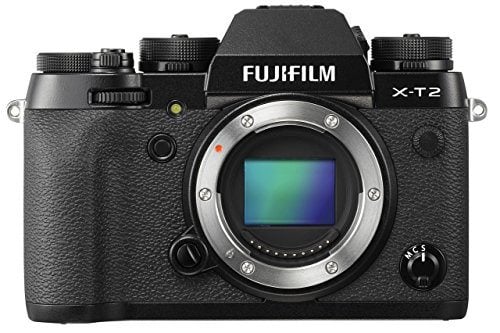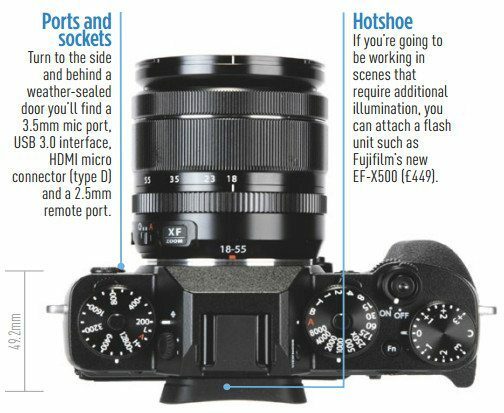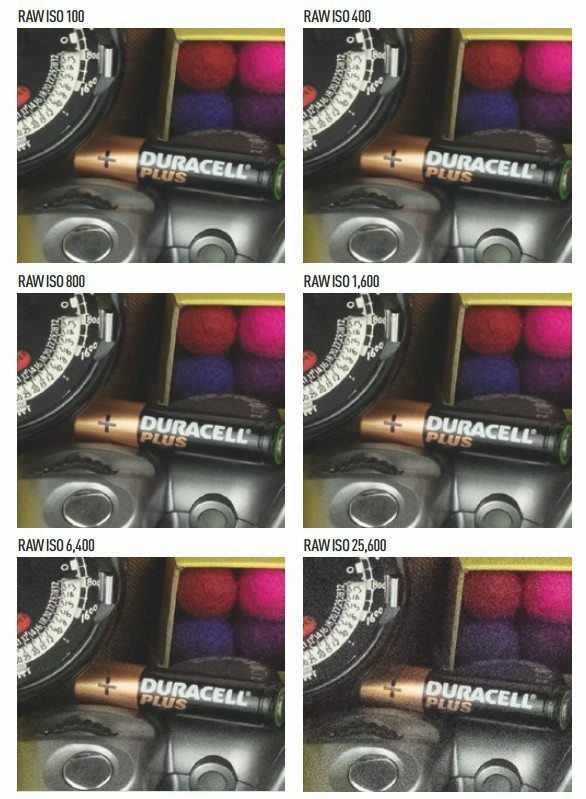Fujifilm X-T2 Review

Mirroless enthusiasts have been eagerly awaiting this camera, but does the Fujifilm X-T2 have what it takes to be a DSLR killer? Michael Topham puts it to the test

EVER since Fujifilm announced its first model in the X series in 2011, the system has been evolving at quite a pace. The number of interchangeable-lens cameras in the X series now stands at eight models, and there’s a healthy range of 19 premium XF lenses to choose from – a far cry from the three optics that were initially available with the release of the X-Pro1. Today, it’s the X-Pro2 that claims the title of being the flagship model in the line-up, but it’s the introduction of the X-T2 that seems to have generated the most interest among admirers and users of the X series.
Unlike its digital rangefinder-style sister models, the X-T2 is more in keeping with the shape and style of a conventional DSLR, and it’s the blend of a beautifully sculpted handgrip, centrally positioned electronic viewfinder and classic arrangement of buttons and dials that will make DSLR users feel right at home. In the same way as the X-T1 inherited technology from the X-Pro1, we were expecting the X-T2 to embrace some of the excellent features and functionality from the X-Pro2 to ensure it goes one better than the company’s first attempt at a DSLR-shaped model.
200-12,800 (100-51,200 extended)
325-point or 91-point hybrid AF
Up to 14fps continuous shooting
Dual SD slots
4K video
Features
The design of the X-T2 doesn’t seem radically different from that of the X-T1, but there are many refinements to get excited about.
Look beyond its hard wearing magnesium-alloy chassis and you’ll realize there’s a lot more than first meets the eye.
The new model is equipped with the same 24.3-million-pixel X-Trans CMOS III sensor and X-Processor Pro as the X-Pro2.
This combination provides a sensitivity range that covers ISO 200-12,800 (expandable to ISO 100-51,200). Unlike the X-T1, which didn’t allow users to shoot in raw at ISO 100, 12,800 or 25,600, the X-T2 doesn’t turn off raw image recording when you shoot in its extended settings.
The X-T1 was no slouch when it came to continuous shooting, but the pairing of the X-T2’s new sensor and processor presents numerous speed benefits. Not only can it shoot at up to 8fps, with a buffer of 27 raw files or 73 JPEGs, but it’s also possible to increase the top-end speed by attaching a new vertical booster grip. Set to its performance-enhancing boost mode, the continuous shooting speed soars to 11fps using the mechanical shutter, or a blazing 14fps using the X-T2’s electronic shutter. Entering live-view mode sees the frame rate drop to 5fps, while the start-up time and shutter lag have been reduced to 0.3sec and 0.045sec respectively. As we’ve seen on previous X-series models, there’s a mechanical focal-plane shutter with a 1/8,000sec limit and the option to extend the fastest speed to 1/32,000sec by employing the silent electronic shutter.
The viewfinder is similar to that in the X-T1. It uses a 2.36-million-dot OLED display with 0.77x magnification and 100% coverage, but improvements have been made. Fujifilm claims to offer a stop better image quality in low light and the EVF refresh rate can be increased from 60fps to 100fps in the camera’s boost mode. Selecting the faster of the two refresh rates does come with one compromise – it consumes more power. The display lag time of the EVF now stands at just 0.005sec. With reduced black-out time (0.13sec that reduces to 0.114sec with the power booster) and improved sensor readout and processing speeds, the X-T2 can now take up to five auto focus readings between frames during continuous shooting to improve the hit rate of sharp shots when faced with shooting the fastest of subjects. To put this in perspective, the X-T1 previously only managed one auto focus reading between frames.
This leads us nicely onto the X-T2’s hybrid auto focus system, which features a central, square phase-detection region covering half the frame width and three quarters of its height. Contrast-detection points are employed outside this area, and users are given the choice of either a 91-point AF array, which splits the frame into a 7×13 grid, or there’s a 325-point layout consisting of a 13×13 central grid of phase-detection points with a 6×13 grid of contrast-detect points either side. As before, single and continuous AF modes are selected from the front of the body, and there are five new auto focus case modes similar to those you get on Canon DSLRs. These are located from the AF-C custom settings in the main menu. By switching the camera from Normal to Boost mode (formerly known as high-performance mode), the AF acquisition speed improves from 0.08sec to 0.06sec.
The big news at the rear of the body is the X-T2’s tilting screen mechanism. Unlike the X-T1’s display that can only tilt up and down, the X-T2 adds an additional hinge on the right edge that, when released using a sliding catch on the opposite side, allows users to tilt the screen 60° upwards. As well as being able to shoot at a low level and at arm’s-length above crowds in the landscape format, the X-T2 now lets you do the same in the portrait format. It’s an ingenious design that has been executed superbly. As for the specs of the screen, this remains the same as that found in the X-T1, being 3in, with a 3:2 aspect ratio and 1.04-million-dot resolution compared to the 1.62-million-dot screen on the X-Pro2.
The X-T2 receives an improved graphical user interface and inherits the beautiful Arcos black & white simulation modes we loved so much on the X-Pro2. And it’s not just in the area of stills where the X-T2 improves, either. It becomes the first Fuji X-series model to sport 4K UHD video recording (3,840×2,160 pixels) at 30fps, 25fps or 24fps for up to 10mins without the vertical booster grip, and 29mins 59secs with it attached. Full HD (1,920×1,080) at up to 60fps is also on offer using the full width of the sensor, with the bit rate for 4K and full HD standing at 100Mbps. It’s good to see that the X-T2 adds a standard 3.5mm stereo microphone input at the side, and there’s a new flat F-Log profile that videographers will want to explore when grading in post-production.
Build and handling
There was a lot to like about the X-T1’s build quality. It demonstrated that it was strong enough to survive heavy day-to-day use, and the same can be said of the X-T2. Pick it up and you instantly get the impression it’s built to last. And with no fewer than 63 weather seals around the body it reassures you that you can keep shooting in inclement conditions and not let the weather be the judge of when you stop.
Although there was nothing glaringly wrong with the X-T1’s ergonomics, changes have been made to make the X-T2 an even more intuitive and enjoyable camera to operate. The new AF-point toggle selector it inherits from the X-Pro2 is a prime example. It saves you shifting the AF point using the four-way controller. It’s great for nudging the AF point quickly and highlights the position of your AF point with a single press or instantly repositions the AF point back to the center with a double press.
Those with an eye for detail will notice that the small movie-record button on the top-plate has been removed. Users will now find movie mode added to the drive-mode settings beneath the ISO dial, and it’s the shutter button that’s used to start and stop a recording. Below the shutter-speed dial are four metering modes (multi, spot, average and centreweighted), but I did find it rather difficult to rotate it with my index finger when it was set to average or spot. The same can be said for the drive-mode switch, which has the same design and could be made easier to rotate from its panorama setting.
The level of customization on the X-T2 is sublime. Head into the set-up menu and enter the button/ dial settings and you will be able to assign different tasks to one of the six customization function buttons around the body. In addition, it’s possible to assign new roles to the rear AE-L and AF-L buttons. In use, I found myself assigning AF-ON to the AE-L button at the rear of the camera for back-button focusing, and I set wireless communication to the Fn1 button on the top-plate to initiate a faster Wi-Fi connection with my mobile devices running Fujifilm’s camera remote app.
In a similar way to the X-Pro2, the X-T2 benefits from dual card slots. It supports the high-speed USH-II standard, and as well as being able to back up both cards simultaneously, you can set the camera to switch to the second card when the first is full, record raw files to one and JPEGs to the other, and specify which you want to use for recording movie footage.
Particularly impressive is the X-Pro2’s ability to focus faster and more accurately than any other X-series model we had tested before.
With the X-T2, Fujifilm has gone one step further to ensure it satisfies photographers who demand that their camera is capable of capturing the fastest of subjects sharp at any split second. For tracking focus on moving subjects, the X-T2 introduces five presets in the AF-c custom settings. These can be used to fine tune how the camera reacts to the way in which the subject moves within the frame, how fast the subject moves and where in the frame the camera priorities focus. They are designed to enable the AF to perform at its best in a host of different circumstances.
While Set 1 is the standard multipurpose mode that’s used by default when there is no specific AF-c custom setting selected, Set 2 is designed to ignore obstacles that come between a subject that’s in the process of being tracked. Set 3 is proposed for focusing on subjects that accelerate or decelerate toward the camera, while Set 4 should be used for erratic subjects that suddenly enter in the frame. Set 5 is intended for obtaining optimum settings for accurate subject tracking, and Set 6 is a custom setting that puts manual control in the hands of users. Three factors: tracking sensitivity, speed-tracking sensitivity and zone area switching can be adjusted to the users personal preference. This is achieved using the X-T2’s front and rear command dials, with both falling nicely to hand.
Another minor alteration involves the exposure-compensation dial that now has a ‘C’ setting. This setting gives users the opportunity to dial in up to ±5EV using the front command dial and check what it’s set to via an exposure scale that’s presented on the left edge of the screen/EVF.
Turning the camera upside down also reveals the tripod thread is now in line with the optical axis where it was offset on the X-T1.
The X-T2 is fractionally larger and heavier than the X-T1, but when you close your eyes and pick one up and then the other, you really can’t tell the difference.
The hand grip fits the average-sized hand extremely well, and very importantly, it’s comfortable to hold over long spells of shooting. The only thing I’d change would be the way ISO sensitivity is controlled from the top-plate ISO dial. Had Fujifilm introduced a ‘Q’ setting or such to the ISO dial, users could, if they wanted, override the dial on the top-plate and access ISO via the quick menu or assign it to a function button. This would get around the issue of pulling your hand away from supporting a heavy lens – something I found awkward with telephoto zooms.
A series of small refinements add up to make the X-T2 a better all-rounder for enthusiasts and pros
Power Booster
The Power Booster Grip (VPB-XT2) brings no end of performance gains to the X-T2. With regards to shooting stamina, it ups the 330-shot limit of a single battery to 970 shots with the grip attached and two additional batteries inserted. Switch the camera to its ‘Boost’ mode and the 200-shot limit of a single battery increases to 580 shots with the power booster attached. Note that these figures are based on using the camera’s electronic viewfinder.

Performance A lot of the hype has centered around the speed of the X-T2’s auto focus, which, for a camera that’s designed to appeal to a wide range of users, including wildlife, action and sports photographers, has to be excellent if it’s going to win over those looking to make the switch from a DSLR system to mirror less. Eighteen months after the X-T1 first hit the market, Fujifilm issued a firmware update that was designed to improve AF response when tracking moving subjects, but this never really cut the mustard with photographers shooting the fastest action. Given the choice of an X-T1 or a similarly priced DSLR to shoot action or sport, I’d choose the latter every time. It was when I used the X-Pro2 alongside an X-T1 at a motor sport event earlier this year that it became obvious how far the speed, accuracy and response of auto focus on Fujifilm’s latest models has come. The X-Pro2 made the X-T1 feel slow and lethargic. I left the track that day knowing that if the replacement for the X-T1 could focus nearly as fast as the X-Pro2, Fujifilm would have a very serious camera on its hands.
The first opportunity I had to put the X-T2 through its paces was at a motor sport event in Le Mans, France, where, within the space of a few minutes and a few bursts at 11fps with the power booster grip attached, I knew I was holding on to a seriously fast camera. My main concern was whether the auto focus could keep up with cars approaching the camera at speeds of100mph, but with continuous auto focus and Zone AF mode set up it put in an outstanding performance. Out of 19 frames in a burst at 11fps, no more than four were unsharp and unusable. I repeated this test multiple times with the success rate of sharp shots in each burst averaging at 79%. The giant leap the X-T2 makes from the X-T1 in terms of its auto focus speed is an eye-opener, and it finally feels like a match for its DSLR competition.
Loaded with a pair of Lexar Professional 633x SDHC cards, the X-T2 managed to shoot 24 raw fi les at 8fps in Normal mode without the power booster before the buffer capacity was reached. Adding the power booster and repeating the test at 11fps in Boost mode revealed the X-T2 could shoot 23 raw fi les before the buffer kicked in. With the electronic shutter switched on and the power booster attached, I managed to shoot the same number of raw files at 14fps. Shooting exclusively in the JPEG format sees the X-T2 reach its claimed 73 frames at 8fps without the power booster.
With the booster added the X-T2 managed 66 JPEGs at 11fps and 42 at 14fps set to its boost mode.
There’s a lot more besides the autofocus and buffer performance to report on. The tried-and-tested TTL 256-zone metering system rarely skips a beat and produces accurate exposure. The colors captured by the sensor, both in JPEG and raw fi le formats, are resolved in typical Fujifilm fashion.
You get faithful results set to its Standard/Provia mode, but can give colors a real boost by exploring the full suite of film-simulation modes. You can generally rely on the white balance system to produce natural color balance, but there is the option to refine the white balance shift, adjust the color temperature (2,500K-10,000K) as well as save three of your own custom settings.
Silent shooting mode A feature that will prove popular among those who don’t want to interfere or distract their subjects is the X-T2’s silent shooting mode. With the electronic shutter activated, you’ll be able to shoot inconspicuously without a trace of sound when the shutter is fi red. Better still, you can assign a function button to the shutter type to save you having to trawl through the main menu.
Anyone who has used an X-T1 will notice the X-T2’s overhauled menu interface and icons that replace the previously numbered set-up menus. The My Menu setting that gives users the option of customizing their most-used menu settings into one group is an excellent idea – just be warned that the camera returns to the My Menu setting every time the Menu/OK button is used unless it’s kept completely clear.
The combination of electronic viewfinder and one of the best tilting screens we’ve ever used makes the X-T2 a very enjoyable camera to use when composing images. For general shooting I found myself framing up via the viewfinder, but the tilt screen is a godsend for low- and high-angle shots. It prevented me having to crawl around in the dirt on more than one occasion, and it seems absurd that no other manufacturer has come up with this design for a screen before now.
The X-T2 has come a long way in terms of performance, yet it holds on to characteristics, such as its beautiful color rendition, that made the X-T1 so popular.
The only caveat is that to get the best performance it comes at a price.
Add the power booster and two extra batteries to your basket and you’ll soon be looking at an extra £420 to pay on top of the body-only price of £1,399.
But with such an array of extra advantages, not forgetting the way it improves handling in the portrait orientation, it manages to justify its price. It’s an accessory that will need to be churned out as fast as the cameras to keep up with popular demand.
WITH the same sensor and processor combination as the X-Pro2, we expected the X-T2 to produce a comparable set of lab results to its sister rangefi nder model, which it does. Testing the sensor through its range and up to its sensitivity ceiling of ISO 51,200 reveals a near-identical noise performance to the X-Pro2. Users of the X-T2 will have no uncertainties of noise severely degrading image quality between ISO 100-6,400, and colour noise in particular is controlled extremely well. The X-T2 clearly benefi ts from the lack of a low-pass fi lter. The level of detail the sensor resolves right up to ISO 12,800 and 25,600 is extremely impressive and worthy of recognition.
Noise
Both raw and JPEG images taken from our diorama scene are captured at the full range of ISO settings. The camera is placed in its default setting for JPEG images. Raw images are sharpened and noise reduction applied, to strike the best balance between resolution and noise.

The X-T2 produces exceptionally clean results with barely any trace of luminance noise between ISO 100 and ISO 800. At ISO 1,600 you can make out luminance noise starting to creep in, but it’s not a major concern and you won’t notice it unless you go searching for it. Luminance noise is more apparent in images taken at ISO 3,200 and 6,400, but with a touch of noise reduction applied there’s nothing that should stop you pushing to these sensitivities if needed. Rotating the ISO dial to ISO 12,800 introduces more luminance noise, but the level of fine detail that’s recorded remains high. I wouldn’t hold back from using this setting, but images do require some vigilant application of noise reduction in post. Users could turn to the expanded ISO 25,600 setting in an emergency, but ISO 51,200 should be avoided as there’s a big drop in saturation.
VILTROX 13mm f/1.4 F1.4 Fuji x Mount Ultra Wide Angle APS-C AF...
- Ultra wide-angle lens is designed for APS-C-format FUJIFILM X-mount mirrorless cameras. with it , you could portray anything. You can shoot environmental portrait, cityscape, landscape, architecture, or even macro photography.
- Ultra wide-angle lens is designed for APS-C-format FUJIFILM X-mount mirrorless cameras. with it , you could portray anything. You can shoot environmental portrait, cityscape, landscape, architecture, or even macro photography.
- The lens features an STM motor for quick, quiet linear autofocus performance, which captures the fast-moving objects. supports eye focus, EXIF information transmission and USB upgrade.
- With its bright maximum aperture of F1.4, you can combine beautiful bokeh with a uniquely wider perspective, to create sweeping scenic landscapes.
- With a minimum focusing distance of 8.6in (22cm), there’s immense potential to add a more dynamic look to your images through simply moving your camera closer and further away from your subject.
- Manual focusing aperture ring provides smooth, even rotation from one end to the other. This makes pulling focus a breeze when recording video and selective focus simple when photographing through objects like prisms and loupes.
When you purchase through links on our site, I may earn an affiliate commission. Here’s how it works.
















The minor flaw you mentioned was solved with firmware 2.00; you can assign ISO to the front command dial.
Thanks for your sharing. I updated my post.